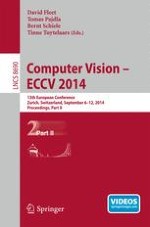The seven-volume set comprising LNCS volumes 8689-8695 constitutes the refereed proceedings of the 13th European Conference on Computer Vision, ECCV 2014, held in Zurich, Switzerland, in September 2014.
The 363 revised papers presented were carefully reviewed and selected from 1444 submissions. The papers are organized in topical sections on tracking and activity recognition; recognition; learning and inference; structure from motion and feature matching; computational photography and low-level vision; vision; segmentation and saliency; context and 3D scenes; motion and 3D scene analysis; and poster sessions.
